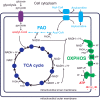Combined defects in oxidative phosphorylation and fatty acid β-oxidation in mitochondrial disease
- PMID: 26839416
- PMCID: PMC4793296
- DOI: 10.1042/BSR20150295
Combined defects in oxidative phosphorylation and fatty acid β-oxidation in mitochondrial disease
Abstract
Mitochondria provide the main source of energy to eukaryotic cells, oxidizing fats and sugars to generate ATP. Mitochondrial fatty acid β-oxidation (FAO) and oxidative phosphorylation (OXPHOS) are two metabolic pathways which are central to this process. Defects in these pathways can result in diseases of the brain, skeletal muscle, heart and liver, affecting approximately 1 in 5000 live births. There are no effective therapies for these disorders, with quality of life severely reduced for most patients. The pathology underlying many aspects of these diseases is not well understood; for example, it is not clear why some patients with primary FAO deficiencies exhibit secondary OXPHOS defects. However, recent findings suggest that physical interactions exist between FAO and OXPHOS proteins, and that these interactions are critical for both FAO and OXPHOS function. Here, we review our current understanding of the interactions between FAO and OXPHOS proteins and how defects in these two metabolic pathways contribute to mitochondrial disease pathogenesis.
Keywords: disease; mitochondria; protein complex assembly; protein interactions; supercomplex.
© 2016 Authors.
Figures


Similar articles
-
Understanding the role of OXPHOS dysfunction in the pathogenesis of ECHS1 deficiency.FEBS Lett. 2020 Feb;594(4):590-610. doi: 10.1002/1873-3468.13735. Epub 2020 Jan 29. FEBS Lett. 2020. PMID: 31944285 Review.
-
The Pathogenesis of Very Long-Chain Acyl-CoA Dehydrogenase Deficiency.Biomolecules. 2025 Mar 14;15(3):416. doi: 10.3390/biom15030416. Biomolecules. 2025. PMID: 40149952 Free PMC article. Review.
-
Loss of the Mitochondrial Fatty Acid β-Oxidation Protein Medium-Chain Acyl-Coenzyme A Dehydrogenase Disrupts Oxidative Phosphorylation Protein Complex Stability and Function.Sci Rep. 2018 Jan 9;8(1):153. doi: 10.1038/s41598-017-18530-4. Sci Rep. 2018. PMID: 29317722 Free PMC article.
-
Evidence for physical association of mitochondrial fatty acid oxidation and oxidative phosphorylation complexes.J Biol Chem. 2010 Sep 24;285(39):29834-41. doi: 10.1074/jbc.M110.139493. Epub 2010 Jul 27. J Biol Chem. 2010. PMID: 20663895 Free PMC article.
-
Mitochondrial medicine: a metabolic perspective on the pathology of oxidative phosphorylation disorders.Cell Metab. 2006 Jan;3(1):9-13. doi: 10.1016/j.cmet.2005.12.001. Cell Metab. 2006. PMID: 16399500 Review.
Cited by
-
Gut microbiome synthesizes important core metabolites to prevent cognitive decline and mitigate onset and progression of Alzheimer's disease.J Alzheimers Dis Rep. 2024 Dec 23;8(1):1705-1721. doi: 10.1177/25424823241309024. eCollection 2024. J Alzheimers Dis Rep. 2024. PMID: 40034366 Free PMC article.
-
Metabolic pathways in immune senescence and inflammaging: Novel therapeutic strategy for chronic inflammatory lung diseases. An EAACI position paper from the Task Force for Immunopharmacology.Allergy. 2024 May;79(5):1089-1122. doi: 10.1111/all.15977. Epub 2023 Dec 18. Allergy. 2024. PMID: 38108546 Free PMC article. Review.
-
Lipotoxic Proximal Tubular Injury: A Primary Event in Diabetic Kidney Disease.Front Med (Lausanne). 2021 Oct 25;8:751529. doi: 10.3389/fmed.2021.751529. eCollection 2021. Front Med (Lausanne). 2021. PMID: 34760900 Free PMC article. Review.
-
Impact of Dietary Factors on Brugada Syndrome and Long QT Syndrome.Nutrients. 2021 Jul 21;13(8):2482. doi: 10.3390/nu13082482. Nutrients. 2021. PMID: 34444641 Free PMC article. Review.
-
Mutual information for detecting multi-class biomarkers when integrating multiple bulk or single-cell transcriptomic studies.Bioinformatics. 2024 Nov 28;40(12):btae696. doi: 10.1093/bioinformatics/btae696. Bioinformatics. 2024. PMID: 39563471 Free PMC article.
References
Publication types
MeSH terms
Substances
LinkOut - more resources
Full Text Sources
Other Literature Sources
Medical

